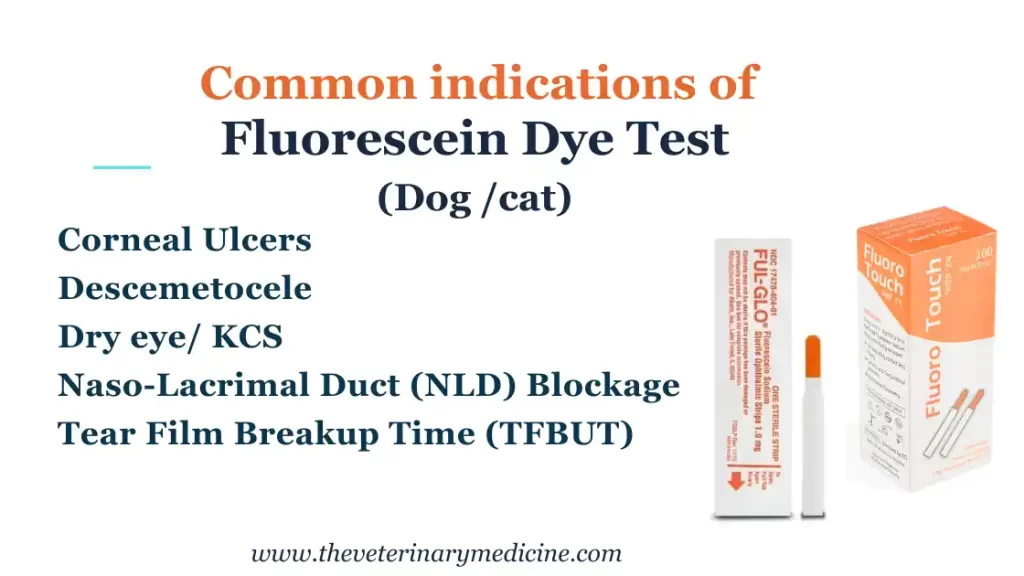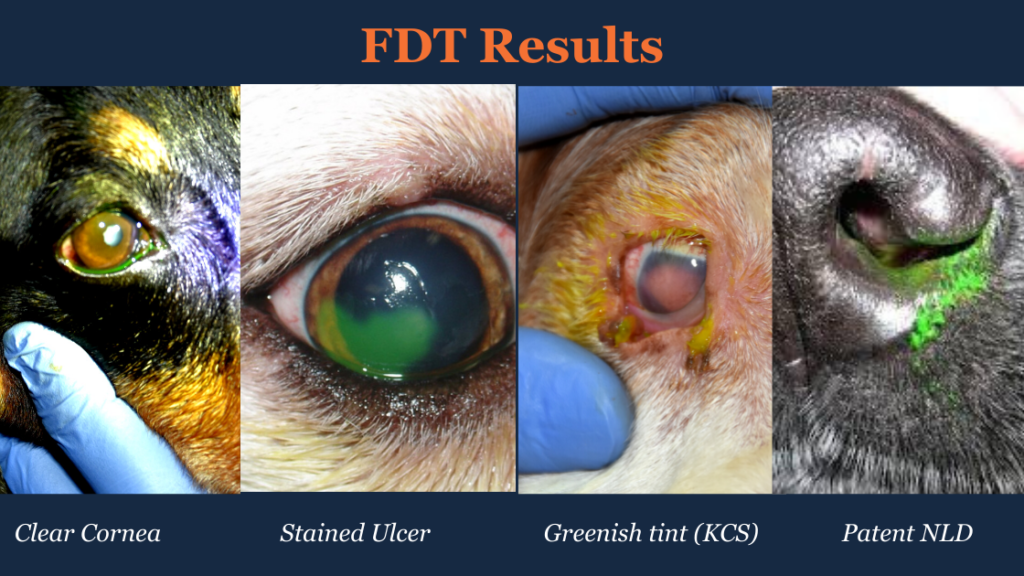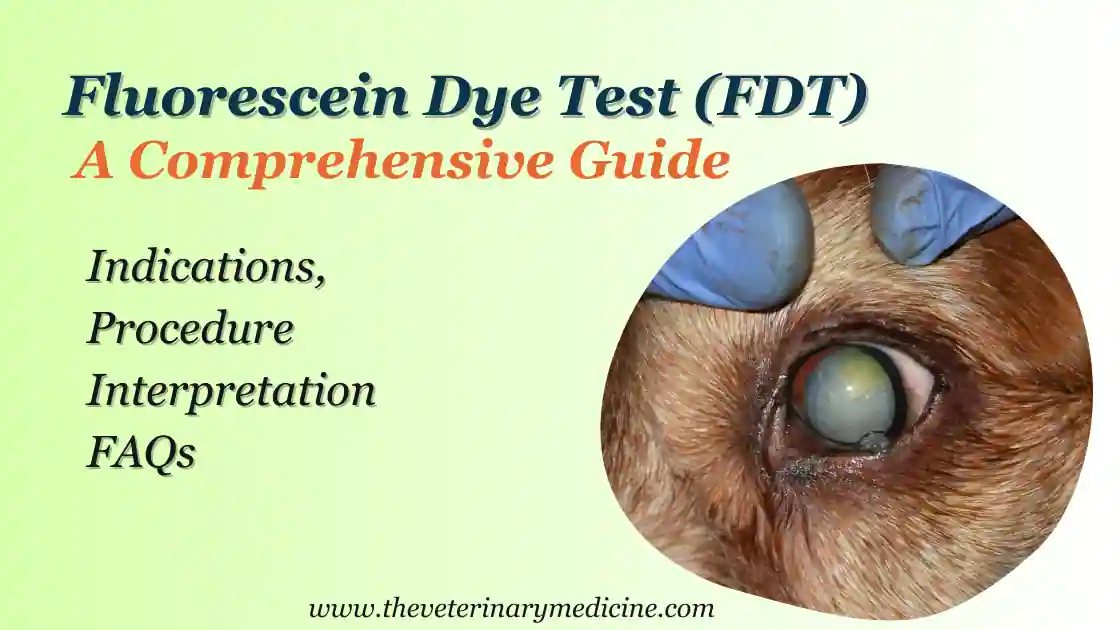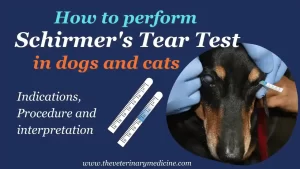Diagnosis of Corneal Epithelial Defects in Pets (Dogs/ Cats) Using Fluorescein Dye Test (FDT)
The Fluorescein Dye Test (FDT) is a non-invasive diagnostic procedure used to detect and evaluate corneal injuries, ulcers, and other abnormalities in pets (dogs and cats). The cornea, a transparent outer layer of the eye, is highly sensitive and vulnerable to injuries. When damaged, it can lead to pain, redness, and even vision impairment in our beloved companions. So, let’s embark on this illuminating journey to better understand how this test can be a beacon of hope for your pet’s ocular health.
Sometimes, pets encounter eye issues that require prompt attention. One valuable tool in diagnosing ocular problems is the Fluorescein Dye Test. In this comprehensive guide, we will delve into the intricacies of this test, including its indications, materials needed, dos and don’ts, and how to interpret the results.
Understanding the Fluorescein Dye Test:
The Fluorescein Dye Test or FDT is a cheap, economic, easy to perform, non-painful, non-invasive diagnostic procedure used to detect and evaluate corneal injuries, ulcers, defects and other abnormalities like KCS and NLD blockage in dogs and cats.
The cornea or transparent outer layer of the eye, that is highly sensitive and vulnerable to injuries and infections. It is more prone for injuries in brachycephalic breeds like pug, Shih Tzu, Lhasa Apso which has pseudoexophthalmos condition due to shallow eye orbit. When cornea is damaged, it can lead to discomfort, pain, redness, discharge and even vision impairment or loss of the eye.
How Fluorescein Dye Works:
Fluorescein is a water soluble, lipophobic dye. It stains pericorneal tear film. It does not remain in contact with normal intact corneal epithelial surface with lipid cell membranes. Breach in corneal surface results in exposure of stroma which absorbs and retains the stain but Descemet’s membrane does not uptake stain. So, the deep area of defect usually remains clear and the periphery of ulcer uptakes stain which appears bright green. Such deep ulcers pose the threat of serious complications like eyeball rupture if not addressed properly.
Indications for the Fluorescein Dye Test (FDT):
- Ocular Trauma: If your pet experiences trauma to the eye due to accidents, scratches, or foreign objects, the Fluorescein Dye Test is essential to assess the extent of injury.
- Corneal Defects like Ulcers and Descemetocele (Seidel Test): Corneal ulcers / Descemetocele are open sores on the cornea, often caused by infections, irritants, or underlying medical conditions. This test aids in identifying the presence and severity of ulcers.
It is also used to check full thickness defects in cornea or sclera that is called Seidel Test. Leakage of aqueous humour can be detected using this test under cobalt blue light or ultraviolet light.
- Dry Eye (Keratoconjunctivitis Sicca): Pets suffering from dry eye have insufficient tear production, leading to discomfort and potential corneal damage. Fluorescein Dye Test helps in determining the extent of dryness and assess the impact on the cornea.
- Nasolacrimal Duct Blockage (NLD Blockage)- Jones Test: Pets suffering from epiphora or tear streak problem may be having the blockage of NLD and FDT is the simplest test to perform which can help in ruling out it. In case of a patent NLD, dye is observed at the external nares after some time/ a few minutes (5 to 15 minutes). But false interpretation of blockage can be made if NLD terminates in caudal nasopharynx.
- Tear Film Breakup Time (TFBUT): Pets suffering from KCS may have quantitative or qualitative tear film deficiencies. FDT can be used to measure TFBUT in pets to rule out qualitative tear film deficiency resulting into dry eye.
- Cataract Surgeries: FDT is also performed in dogs and cats undergoing cataract surgery as a routine test.

Materials Needed for FDT:
Performing the Fluorescein Dye Test (FDT) requires a few simple yet vital materials:
- Fluorescein Dye Strips: These are small, delicate, non-calibrated, sterile paper strips soaked in fluorescein dye (impregnated part orange in colour), a harmless substance that binds to damaged corneal tissue. Each strip usually contains 0.6 to 1 mg of fluorescein sodium. Fluorescein is a water-soluble dye that appears green tinted and glows under the blue light.
Fluorescein is also available in form of liquid solution (1% or 2%) but impregnated strips are easily available and sterility can be maintained for each test being performed without worries of contamination and infection. If using single use fluorescein solution then put 1 to 2 drops over the cornea and conjunctival fornix.
- Sterile Saline Solution: It is needed to rinse the eye before and after the test, ensuring accurate results.
- Cotton Balls or Gauze: These are needed to gently dry the excess tears from the eye before applying the dye.
- Slit Lamp or Blacklight: A specialized light (cobalt blue) source used to illuminate the dye in the eye, making any damage or irregularities visible. A dark room may be required for better visualization.
How to perform FDT:
- Assemble all the material needed to perform the test.
- Calm the pet and muzzle if needed.
- Wash the hands and wear the gloves.
- Tear the strip pack carefully and take out the strip.
- Rinse the eye prior to performing the test to remove debris, mucus or discharge if needed.
- Lower the eyelid to expose the conjunctiva. Put the strip on the moist conjunctiva.
- Use drops of sterile saline solution to moisten the strip if needed to avoid discomfort or in case of insufficient tears like KCS.
- Leave the stain on eye for some time (usually for 1 minute) and allow the pet to blink few times to evenly distribute the dye over the corneal surface.
- After applying the Fluorescein dye, excess stain can be removed by irrigating with normal saline solution (0.9%) if needed.
- Observe the area or corneal surface carefully with slit lamp with a cobalt blue filter or ophthalmoscope under blue light.
- Flush the eye/ eyes with normal saline or Ringer’s lactate to remove excess stain from the eye after completion of the procedure.
If pet doesn’t allow to put strip in the eye due to irritation, then impregnated portion of the strip can be put in 0.5 to 1 ml of sterile saline solution and this greenish solution can be used to perform the test. Or use ready-made sterile fluorescein solution.
In case of severely painful eye a drop of topical anaesthetic like proparacaine can be used to make the procedure easier. Still if you feel that it is unsafe to perform the test without sedation then a short acting anaesthetic or sedative can be given. Use of topical anaesthetic may hamper the STT values.
Dos and Don'ts:
Do:
- Seek Professional Guidance: While the Fluorescein Dye Test can be performed at home, it is recommended to consult your veterinarian for proper guidance and to ensure accurate interpretation of results. It can result in inadvertent corneal injury if performed without experience.
- Maintain a Calm Environment: Before attempting the test, create a calm and comfortable environment for your pet to reduce anxiety. Pets can be muzzled if needed in case of aggression or uncooperative behaviour for easy handling.
- Use Sterile Materials: Ensure all materials used, including your hands, are clean and sterile to prevent iatrogenic infections.
- Be Gentle: Handle pet’s eye with care, using minimal pressure when applying the dye and wiping away excess tears.
Don’t:
As such there are no such real contraindications to perform FDT in pets with eye problems. Still some considerations are there –
- Don’t Self-Diagnose: Should be performed by a vet care professional. Even if you perform the test at home, it’s important not to jump to conclusions. Always consult your veterinarian for an accurate diagnosis and treatment plan.
- Don’t Use Damaged Dye Strips: If the dye strips are damaged or expired, they may not yield accurate results. Always use fresh, intact strips.
- Don’t Force Your Pet: If your pet is uncooperative or shows signs of distress, it’s best to stop the procedure and consult your veterinarian.
- Avoid Corneal Irritation: Touch the strip on conjunctiva only. Do not touch the strip on cornea in order to avoid unnecessary corneal irritation or damage.
Results Interpretation:
Healthy corneas will not retain the dye, while damaged areas, such as ulcers or scratches, will appear as bright green spots where the dye has adhered to the affected tissue. The intensity and location of staining can provide insights into the nature and severity of the problem.
- No Staining: If no staining is observed, it indicates a healthy cornea without any obvious damage.
- Staining in Specific Areas: Staining in localized areas suggests the presence of corneal ulcers or abrasions. The severity and location of the staining provide insights into the extent of the injury (size, depth and type). Green spot is suggestive of corneal epithelial defect while a black spot (donut or halo shaped with no stain in the center of circle) is indicative of descemetocele. Conjunctival ulcers stain yellow-orange.
- Generalized Staining: If the dye uniformly adheres to the entire cornea, it might indicate dry eye or other underlying issues affecting tear distribution. Roughened areas of cornea usually appear as light green haze, indicating corneal scarring.
Note: Chances of false positive interpretation are there in case of improper irrigation of the eye after staining and false negative results for NLD patency in brachycephalic dogs (due to brachycephalic ocular syndrome, medial canthus entropion or duct opening in the mouth near soft palate).
Documentation of the Test:

If you notice any staining or abnormalities, it’s crucial to document your observations. Note the location, size, and intensity of the stain.
Take clear photos, if possible, as this can be helpful for further evaluation and comparison during follow up.
Conclusion:
As pet owners and Vets our furry friends rely on us to protect and care for them. The Fluorescein Dye Test (FDT) is a valuable tool that enables us to identify and address potential eye issues like dry eye (KCS), corneal ulcers, blocked nasolacrimal duct in pets. While this economic test can be performed at home, it’s crucial to consult a veterinarian for accurate interpretation and appropriate treatment thereafter. By staying proactive and attentive to our pets’ eye health, we can ensure a brighter, clearer, and more comfortable future for them.
FAQs:
What is fluorescein used for in dogs?
It is used for the diagnosis of corneal epithelial defects like ulcer, descemetocele, perforations; NLD blockage, keratitis, KCS etc.
What does a positive fluorescein dye test indicate?
Positive fluorescein dye test is generally indicative of corneal ulcer, descemetoceles, keratitis or dry eye.
How do you use fluorescein strips on a dog?
It is moistened with a drop of sterile saline and placed in the eye on conjunctival part.
What is the use of fluorescein strip test?
It is used for the diagnosis of corneal defects and NLD blockage mainly.
Fluorescein dye/ stain test in dogs side effects?
There are chances of transient blurring of vision, burning, iatrogenic infection, yellowish discoloration and chemosis in rare cases.
Fluorescein dye test in dogs results?
It takes only a few minutes and a positive result is suggestive of corneal injury.
Fluorescein dye test in dogs procedure?
It is a economical test which can be performed in a few minutes and requires minimal instrumentation.
Fluorescein dye test in dogs cost/fluorescein eye stain test cost for cats?
Test cost depends on the area and professional charges. Pack of 100 fluorescein strips may cost around INR 300-500 or USD 16-25. Bulk order or good deal may reduce the cost.
How long does fluorescein eye stain last in dogs?
Usually it is flushed at the end of the test but still can be observed up to 24 hours and severe corneal injury can retain stain up to 5 days.
Remember, the Fluorescein Dye Test can provide valuable information about your pet’s eye health, but it should not replace professional veterinary care. Your veterinarian is the best resource for accurate diagnosis and treatment.





